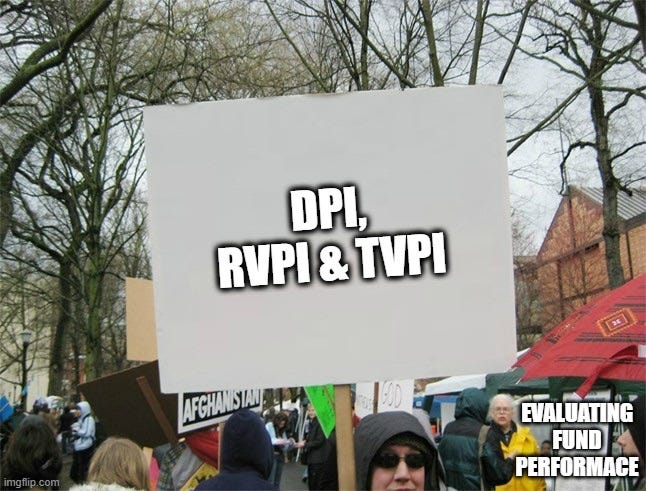Decoding Venture Capital Fund Performance: Unveiling the Distribution, Residual Value, and Total Value
Unlocking the Secrets to Evaluating Investment Success in the World of Venture Capital | Venture Capital Remote Jobs
Hey there, fellow investors, founders & vc enthusiasts!
Welcome to The Venture Crew bi-weekly newsletter on startups, venture capital & technology. Whether you're a seasoned investor or just dipping your toes into the exciting world of startups and innovation, we've got you covered.
Have you ever thought about how the LPs evaluate the performance of venture capital? As you guys may be aware of the fund cycle of vc firm, venture capital generally raised the capital from Limited Partners (LPs) to deploy into the startups. Even for the VC professional it really important to keep track of these terms which give an idea about the performance of their overall investment.
Enter the holy trinity of venture capital fund evaluation: Distribution Paid in Capital, Residual Value Paid in Capital, and Total Value Paid in Capital. These three terms hold the key to unlocking the true performance of a fund and give LPs invaluable insights into its success.
Join 3000+ forward-thinking individuals who are unlocking high-signal, curiosity-inducing content every single day in our VC Newsletter.
Sponsored By…
Fuise.in, a free database search engine tool for founders to find the right investors. Get the 10000+ investors database of various countries like US, Africa, UK, India, Australia and others.
Visit - The investor Database to download the investor database based on your country.
FOR SPONSORSHIP
Visit: Promotion / Advertisement
There are generally three terms that are used to evaluate the performance of a VC fund:
Distribution Paid In Capital (DPI)
Residual Value Paid In Capital (RVPI)
Total Value Paid In Capital (TVPI)
Total Value Paid In Capital (TVPI) = (D+RV) / Paid In Capital(PIC)
Paid in Capital: It is a contributed capital or drawn capital.
Let’s take an example and try to understand each term:
Suppose Limited Partners (LP) committed to invest around $5M in a VC fund and General Partners (GP/VC) ask for an amount of $4M for 3 years out of $5M. So here Paid in Capital (PIC) = $4M.
[ Remember: the Paid In Capital is different from the Committed Capital. The Committed capital is the amount of money that an investor agrees to contribute to the investment fund. here Committed capital is $5M and Paid Capital is $4M (previously mentioned). ]
So what’s the Distribution Paid in Capital (DPI) and Residual Value Paid in Capital (RVPI) in this example?
Distribution Paid In Capital (DPI): It is the amount of money that the VC fund has returned to the Limited Partners, which is low in the early year and increases over the period.
Residual Value Paid In Capital (RVPI): It is the amount of money that remained after the distribution or returned to the Limited Partners.
Ex - Suppose VC Fund has decided to invest in 20 startups and out of that, VC funds have exited from 5 startups and that money is returned to the investors and now the remaining investment is 15 startups. So if the 15 investment value is $150M and cash is around $10M. So the Residual Value of the Fund is $150M + $10M = $160M.
Total Value Paid In Capital (TVPI) = DPI + RVPI
Now, let’s understand all terms with one example of VC fund
Ex: Fund’s Paid In Capital (PIC) = $70M
Distribution Capital (D) = $80M and Residual Capital (R) = $100M (Hope you are getting the idea of what these terms from the above explanation)
Calculation:
Distribution Paid In Capital (DPI) = D / PIC = 80 / 70 = 1.1420X
Residual Value Paid In Capital (RVPI) = R / PIC = 100 / 70 = 1.428X
Total Value Paid In Capital (TVPI) = DPI + RVPI = 1.1420 + 1.4280 = 2.57X
Explanation:
DPI = 1.1420X i.e. Fund has returned to LPs all paid-in capital i.e. $70M and received 14.28 above that original amount paid.
RVPI = Still a lot of value of funds left behind, which will return to LPs in the coming time.
TVPI = Total value of fund utilized.
This means the fund is able to generate more return over the original amount i.e. paid-in capital. You can try out this example to calculate in Excel.
That’s it. I hope it will help you to understand these terms.
Today’s VC Job:
StartFast Ventures - VC Associate - Remote - Apply
Bankless Venture - Investment Analyst - Remote - Apply
Trilogy Equity Partners - Analyst - Remote - Apply
FOR SPONSORSHIP
Get your message in front of Innovators, a startup working professionals and Investors. It’s Easy! The Venture Crew newsletter is read across 15+ Countries and 14 US States.
(We are Open to Promote)
For more Visit: Promotion / Advertisement
Also, don't forget to join our Slack community, The Venture Crew, to connect with like-minded startup enthusiasts and founders.
Subscribed to “The Venture Crew” newsletter to receive daily updates on startups, venture capital, startup investing and vc jobs.
By - The Venture Crew!









Thanks for sharing this! Really Helpful to me!
Sahil you’re late. Today I was asked this question in an interview 😂
Thanks for sharing !!!